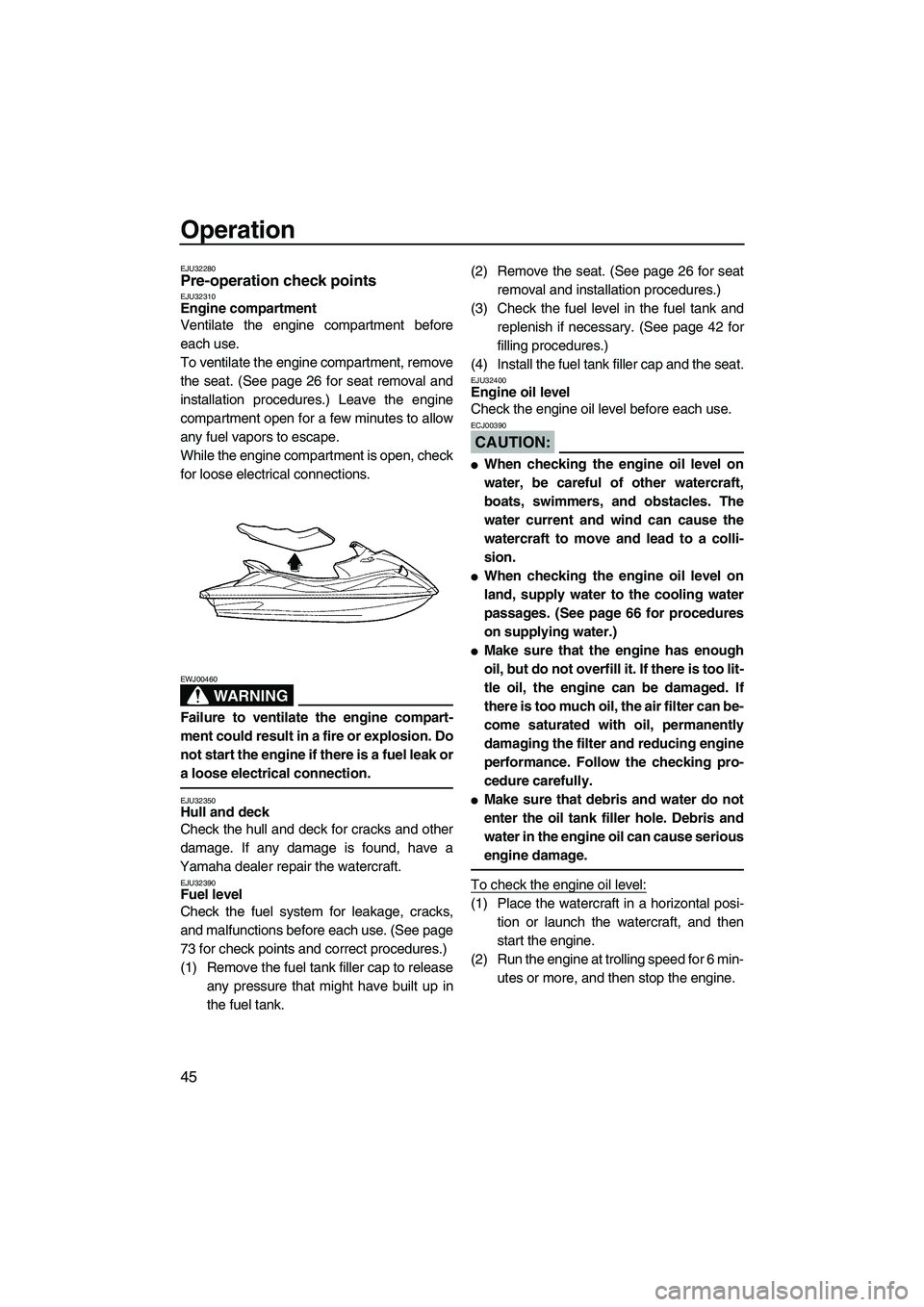Page 49 of 96
Operation
42
EJU31890Engine oil
Use a combination of the recommended SAE
and API engine oil classifications shown in the
chart below.
CAUTION:
ECJ00280
Use only 4-stroke engine oil.
EJU31930Filling the fuel tank
CAUTION:
ECJ00290
Be careful when refueling. Avoid getting
water and other contaminants in the fuel
tank. Contaminated fuel can cause poor
running and engine damage.
(1) Remove the seat. (See page 26 for seat
removal and installation procedures.)
(2) Remove the fuel tank filler cap, and then
slowly add fuel to the fuel tank. Stop filling
when the fuel level reaches approximate-ly 50 mm (2 in) from the top of the fuel
tank as indicated in the illustration.
(3) Install the fuel tank filler cap and the seat.
1Approximately 50 mm (2 in) from top of the
fuel tank
Fuel tank capacity:
60 L (15.9 US gal) (13.2 Imp.gal)
UF1K72E0.book Page 42 Wednesday, August 2, 2006 10:43 AM
Page 52 of 96

Operation
45
EJU32280Pre-operation check points EJU32310Engine compartment
Ventilate the engine compartment before
each use.
To ventilate the engine compartment, remove
the seat. (See page 26 for seat removal and
installation procedures.) Leave the engine
compartment open for a few minutes to allow
any fuel vapors to escape.
While the engine compartment is open, check
for loose electrical connections.
WARNING
EWJ00460
Failure to ventilate the engine compart-
ment could result in a fire or explosion. Do
not start the engine if there is a fuel leak or
a loose electrical connection.
EJU32350Hull and deck
Check the hull and deck for cracks and other
damage. If any damage is found, have a
Yamaha dealer repair the watercraft.
EJU32390Fuel level
Check the fuel system for leakage, cracks,
and malfunctions before each use. (See page
73 for check points and correct procedures.)
(1) Remove the fuel tank filler cap to release
any pressure that might have built up in
the fuel tank.(2) Remove the seat. (See page 26 for seat
removal and installation procedures.)
(3) Check the fuel level in the fuel tank and
replenish if necessary. (See page 42 for
filling procedures.)
(4) Install the fuel tank filler cap and the seat.
EJU32400Engine oil level
Check the engine oil level before each use.
CAUTION:
ECJ00390
�When checking the engine oil level on
water, be careful of other watercraft,
boats, swimmers, and obstacles. The
water current and wind can cause the
watercraft to move and lead to a colli-
sion.
�When checking the engine oil level on
land, supply water to the cooling water
passages. (See page 66 for procedures
on supplying water.)
�Make sure that the engine has enough
oil, but do not overfill it. If there is too lit-
tle oil, the engine can be damaged. If
there is too much oil, the air filter can be-
come saturated with oil, permanently
damaging the filter and reducing engine
performance. Follow the checking pro-
cedure carefully.
�Make sure that debris and water do not
enter the oil tank filler hole. Debris and
water in the engine oil can cause serious
engine damage.
To check the engine oil level:
(1) Place the watercraft in a horizontal posi-
tion or launch the watercraft, and then
start the engine.
(2) Run the engine at trolling speed for 6 min-
utes or more, and then stop the engine.
UF1K72E0.book Page 45 Wednesday, August 2, 2006 10:43 AM
Page 53 of 96

Operation
46
NOTE:
If the ambient temperature is 20 °C (68 °F) or
less, warm up the engine for an additional 5
minutes.
(3) Remove the seat. (See page 26 for seat
removal and installation procedures.)
(4) Remove the oil tank filler cap, wipe the
dipstick clean, and then screw the filler
cap into the filler hole completely. Re-
move the filler cap again and check that
the engine oil level is between the mini-
mum level mark and maximum level
mark on the dipstick.
(5) If the engine oil level is below the mini-
mum level mark, add enough oil so that
the oil level is between the minimum and
maximum level marks on the dipstick,and then install the filler cap. If the engine
oil level is significantly above the maxi-
mum level mark, the oil tank is overfilled.
Have a Yamaha dealer remove the ex-
cessive amount of engine oil.EJU32420Water separator
Check the water separator for water. The wa-
ter separator retains any water that may have
entered through the fuel tank breather hose if
the watercraft was capsized. Normally, the
water separator is empty.
If water remains in the water separator, drain
it by removing the drain screw. Place a drain
pan under the water separator to catch the
draining water or use a dry cloth to soak up
any water that could spill into the watercraft. If
any water spills into the watercraft, be sure to
wipe it up with a dry cloth. Also, be sure to in-
stall the drain screw after draining the water
separator.
EJU32460Bilge
Check the bilge for moisture and fuel residue.
CAUTION:
ECJ00370
Excessive water in the bilge can splash
into the engine, which can result in severe
damage.
1Oil tank filler cap
1Minimum level mark
2Maximum level mark
1Water separator
2Drain screw
UF1K72E0.book Page 46 Wednesday, August 2, 2006 10:43 AM